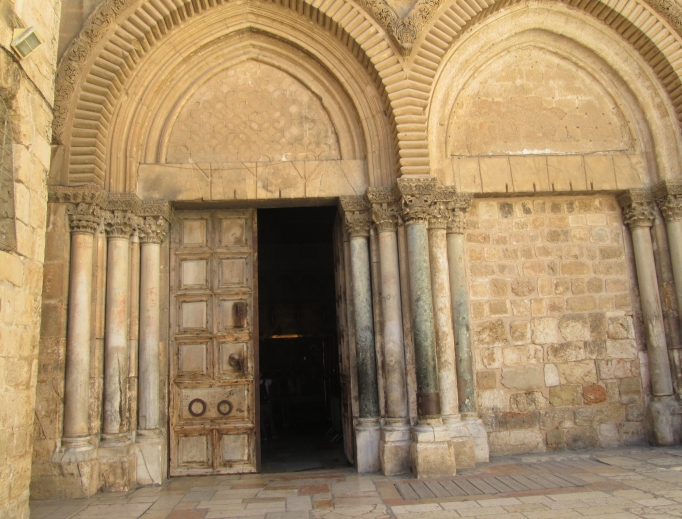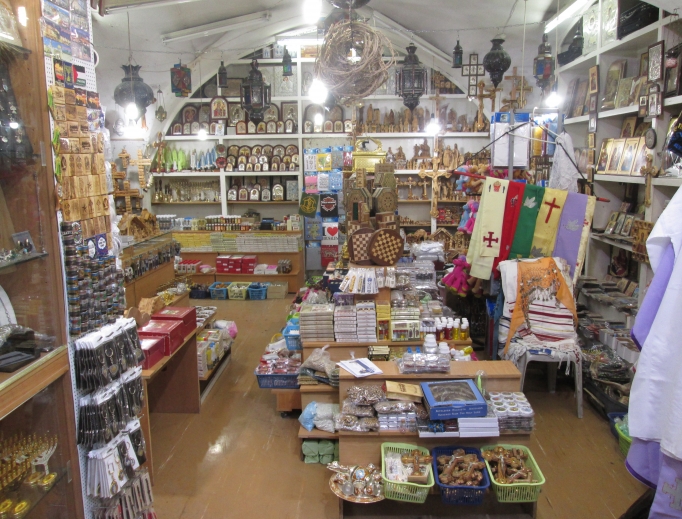Christian Holy Sites in Holy Land Begin Slow Open Because of COVID-19
Christian leaders announced May 26 that the Church of the Holy Sepulcher and the Basilica of the Nativity in Bethlehem would once again welcome the public, with some restrictions.

JERUSALEM — For the past two months Maria Ramos yearned to pray in a church, but the closure of all houses of worship in the Holy Land, aimed at stopping the spread of coronavirus (COVID-19), meant that she and all other people of faith needed to pray at home.
She finally got her wish on Pentecost Sunday.
On that day, May 31, Ramos, a caregiver from the Philippines who works in Israel, returned to the newly opened Church of the Holy Sepulcher to pray at the site of Jesus’ burial and resurrection.
“Being in Israel, the Holy Land, has given me opportunities to deepen my faith,” Ramos said as she emerged from the ancient stone church, located in Jerusalem’s Old City. “This is a special church, and I feel very close to Our Lord when I come here.”
The reopening of churches in both Israel and the Palestinian-ruled West Bank in late May “was gratifying,” said Armenian Orthodox Father Artak Tadevosyan, who manages the Armenian section of the Holy Sepulcher. The sacred site is administratively divided among several Christian denominations.
Even during the height of the pandemic here, a small number of priests continued to celebrate religious services inside the churches, but the public was prohibited.
Many churches livestreamed their services, allowing the faithful to take part, albeit remotely. As restrictions were gradually lifted, priests began to hold outdoor Masses.
“Now up to 50 people are permitted to enter parts of the church, but not Jesus’ tomb,” Father Tadevosyan noted, as he watched worshippers pray outside the Edicule, the structure that covers Jesus’ tomb.
Cautious Opening
On May 2, Christian leaders, including Franciscan Father Franceso Patton, the custos of the Holy Land, announced that the Holy Sepulcher Church and the Basilica of the Nativity in Bethlehem would once again welcome the public, but only if visitors follow safety protocols.
“For safety reasons and in order to avoid the risk of a new spread of the COVID-19 infections, at the beginning the number will be limited to 50 persons, and the basilica will be accessible only to those who have no fever or symptoms of infection and are wearing suitable face coverings,” the leaders said in a statement.
“It will also be necessary to keep a minimal distance of 2 meters (about 6.5 feet) between each person, and to avoid any act of devotion that might include physical contact,” such as touching the stones, icons, vestments and the personnel within the basilica, they said. By custom, pilgrims often kiss the relics located within these sites.
The leaders said visitors to the Holy Sepulcher Church must abide by the same rules.

The Church of the Holy Sepulcher has reopened.
Empty Tomb
Five days after the Holy Sepulcher Church’s opening, a bottle of alcohol gel sat at the entrance, and the four dozen people praying there wore masks. However, in violation of the hygiene rules, some worshippers were seen kissing the Stone of Anointing (Stone of Unction), believed to be the spot where Joseph of Arimathea prepared Jesus’ body for burial.
At the moment, the public is not allowed to enter the Edicule because its entrance is narrow and poorly ventilated.
Given the Holy Sepulcher Church’s massive size, it felt nearly empty the first Sunday it was reopened. At this point, almost no foreigners are being permitted into Israel, the Palestinian Authority and Jordan, so the church’s only visitors are local.
Many aren’t Christian.
“I love Jerusalem, and I love the church, to see the expressions of faith,” said a young Jewish woman named Elsa, who came from Tel Aviv.
Elsa noted that the streets of the Old City — usually packed with foreign tourists — were almost empty.
“It’s emotional,” she told the Register. “I’m used to seeing tons of people, and today there’s almost no one here. So many people rely on tourism, but there aren’t any tourists.”
Another visitor, who declined to give her name, said she was a Buddhist and that she came to the church “because it is a spiritual place. Usually it’s full and noisy. The fact that it is nearly empty is sad, but also provides an unaccustomed sense of peace and quiet.”
The plaza leading to the church was so empty, in fact, that the loudest sound was birds chirping.
No Sales
The dearth of foreign tourists in the Old City, which also houses the Al-Aqsa Mosque compound and the Western Wall, has dealt a devastating blow to the Muslim and Christian storeowners whose little shops line both sides of the stone alleyways leading to the Christian Quarter.
“We were closed for two months due to the virus, and now that we’re open, business is still down 95%,” said Mahmoud Kordih, a Muslim whose shop sells Palestinian embroidery, Bedouin silver and colorful, beaded Middle Eastern jewelry. “The opening of the church hasn’t helped us at all because the borders are still closed.”
The fact that all Israeli and Palestinian businesses were shuttered during Easter, Passover and Ramadan means that anyone dependent on religious tourism is struggling financially, Kordih said.
“We missed high season. I’ve lived through other hard times, including the second intifada, which was also very hard. While wars end eventually, no one knows when this virus will end,” he said.

The shops in the Christian Quarter of the Old City of Jerusalem are empty because Israel’s borders are still shuttered. No pilgrims means no business.
Pastoral Challenges
Franciscan Father Sandro Tomasevic, the parish priest at St. Savior’s Church in Jerusalem, said he and his fellow priests have tried to serve their community, in spite of the long closure.
“At first we celebrated Masses without the public, but in May we held outdoor Masses, in the Spanish sisters’ playground, on the grounds of Tantor,” a Christian institute, the priest explained.
During one three-day period, Father Tomasevic said, the priests held at least 16 Masses in various locations, to accommodate all who wanted to pray communally while adhering to the government’s rules limiting the number of people congregating.
Although he is grateful that the churches have reopened, Father Tomasevic fears that the Israeli government opened schools, restaurants and gyms too soon. Israel has seen a spike in coronavirus cases over the past week, especially in schools.
He said, “Until now there have been very few cases, but maybe they should have waited longer. We are always watching the news. We are adapting, making decisions every day. We respect the law and want to preserve life.”
Michele Chabin is the Register’s Middle East correspondent. She writes from Jerusalem.
- Keywords:
- basilica of the nativity
- bethlehem
- church of the holy sepulcher
- coronavirus
- holy land
- jerusalem
- michele chabin

















